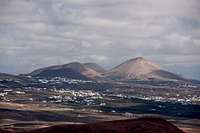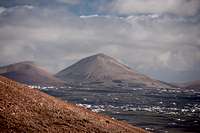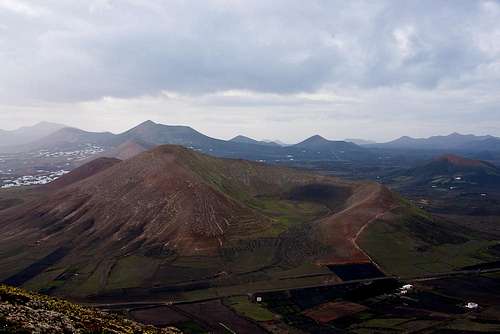-
 17824 Hits
17824 Hits
-
 79.78% Score
79.78% Score
-
 11 Votes
11 Votes
|
|
Mountain/Rock |
|---|---|
|
|
28.97796°N / 13.64047°W |
|
|
Hiking |
|
|
Spring, Summer, Fall, Winter |
|
|
1952 ft / 595 m |
|
|
Overview
At 595m Montaña Blanca is one of the highest volcanoes on Lanzarote. After Montaña de Guardilama it is the second highest mountain of the San Bartolomé Chain and number six of the whole island. Its name - White Mountain - already indicates that it stands apart from all the blackness of the Montañas del Fuego nearby; a pale, perfectly structured volcano cone.
Like much of Lanzarote, Montaña Blanca came into being during a period of volcanic activity between 300 and 500 years ago. About 30 volcanoes erupted along a single fault line which stretches along much of the east coast of the island. Together with Monte Guatisea and Montaña Tersa it forms a trinity, of which it is the central and highest part. While still typical for the Lanzarotenian volcanism, the three craters show a uniqueness in their relative location. Usually - and this is the case with Montaña Blanca - the craters on Lanzarote are open to the north-east. This is due to the fact that during the eruption - just like today - north-eastern trade winds prevailed, piling up the cinder on the far side of the calderas. Monte Guatisea is open to the north - Montaña Tersa is open to the east. Thus one can deduct that the three crraters, while located very close to each other, where created during completely differennt times of the outbreak.
Montaña Blanca's crater, however, has almost withered away by erosion. It is comparattively small, being located high up on the volcano. In size it resembles a football field and is similarly plain. The regular ascent route passes through the crater which - a rare fact for Lanzarote - is denselly covered by grass and bushes. The summit offers fine views of the tourist town along the east coast and across the Montañas del Fuego in the north-west. An antenna and the accompanying power station mar the summit experience somewhat. There are two summit crosses, one on top, the other a bit to the north on a side summit which is visible from Montaña Blanca, the village.
Summit Panorama
Getting There
Though there are ferries from the Spanish mainland to the Canary Islands, they take more than 24h for the trip. Therefore most visitors therefore go by plane. Every travel agency in Europe offers flights, hotel rooms, apartments, rental cars etc. so that reaching the Canaries is rather a matter of money than opportunity. During the summer season flight fares can be reasonable but during the Easter and Christmas holidays you have to be prepared for additional fees of 500€ per person.
Lanzarote has its own airport between the capital Arrecife and one of the main tourist centres, Puerto del Carmen. There are public bus lines but – like on all the islands – they don't run too regularly. If you plan to stay on your own, better take a rental car right at the airport.
Montaña Blanca is the "home volcano" of Arrecife, Lanzarote's capital. It can be easily reached as follows:
- From Arrecife take motorway LZ2 westward to Playa Honda
- Switch to LZ301, which will take you to Guime and the village Montaña Blanca
- Right before reaching the latter there is a roundabout at an intersection with LZ35 (wind chime by C. Manrique)
- Turn west on LZ35 and drive uphill. At the top look for a place to park the car. A dirt road runs in direction of Montaña Blanca.
Red Tape
Montaña Blanca is located at the eastern end of the Paisaje Protegido de la Geria, which was established to protect the wine growing region of Lanzarote. While farming is allowed there, hiking is restricted to the obvious trails. The slopes of Montaña Blanca are very steep and there are deep ruts in the soft ground. Take care not to deepen those ruts.
Accommodation
As for holiday homes, hotels or apartments either consult your nearest travel office, or – search for lodgings on Google. There are several sites on the web, dedicated to rent privately owned houses or apartments. Prices are generally a bit less expensive than for tour operators but you don't have as much security.Weather Conditions
Lanzarote is usually swept by fierce north-western trade winds. Though they deposit their humidity on almost all of the other Canary Islands, Lanzarote is simply too low to form a decent obstacle. Therefore the climate is very arid.
For some time of the year, eastern winds prevail, which almost always carry clouds of Sahara dust with them. Usually this means reduced visibility but in some occasions "Calima" occurs. Fierce storms take up the dust from the Sahara and sweep it across the islands. In these times visibility is nil and sometimes even the planes are grounded.
Maps & Books
Maps
Regular Maps
- Lanzarote
Kompass Map WK241
Kompass Verlag
1:50000
ISBN 3-85491-175-0
Digital Maps
Kompass is the only company known to me which offers GPS digital Maps. In addition for those of you with Garmin GPS receivers there is a map source map set of all Canary islands out there.
- Lanzarote
Kompass GPS4241
Kompass Verlag
ISBN 3-85491-223-4
- Islas Canarias
Map Source custom map
By Manfred Pepper
downloadable zip-file
Books
My recommendation is a guidebook by Rother Verlag, available in German. The book is an excellent hiking guide covering all the interesting areas of the island. Since it comes with small maps for each excursion it might even be used without a map to support them.
- Lanzarote
Rolf Goetz
Rother Verlag
ISBN 3-7633-4302-4









